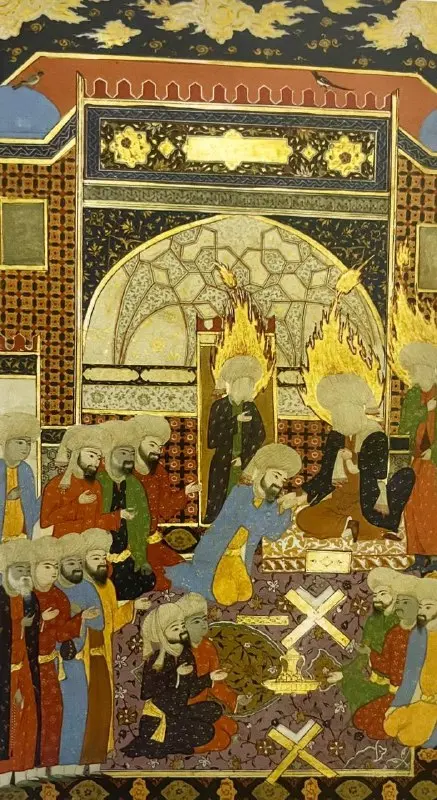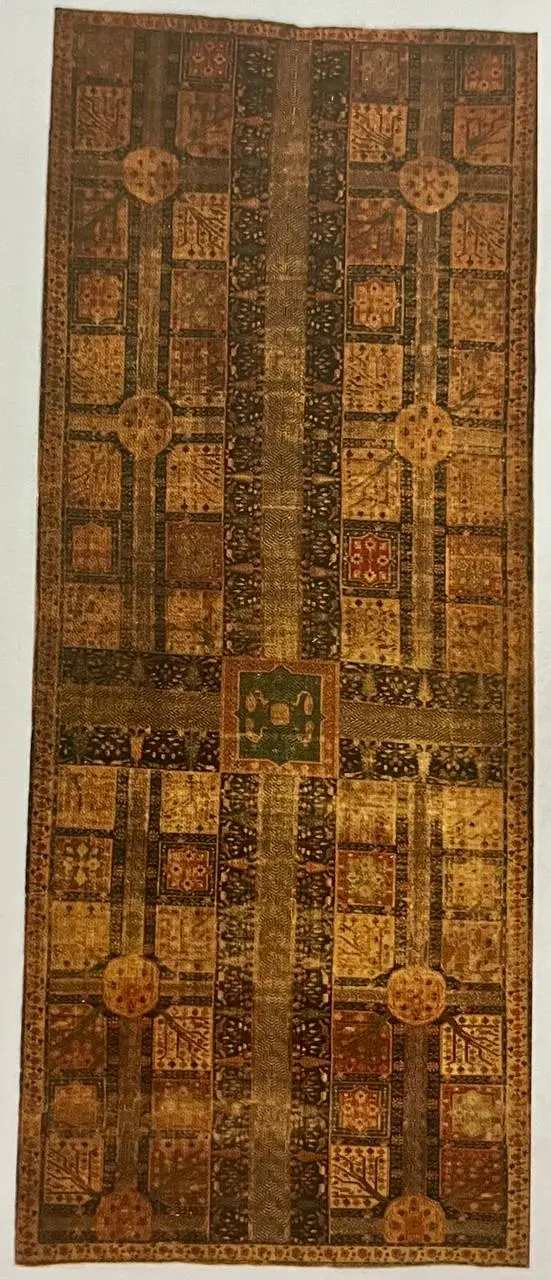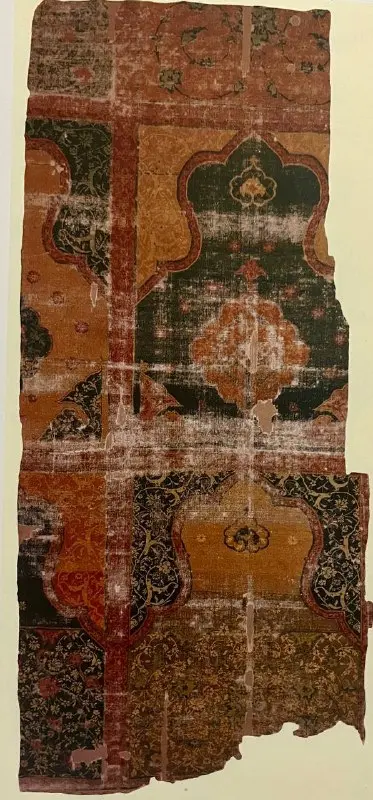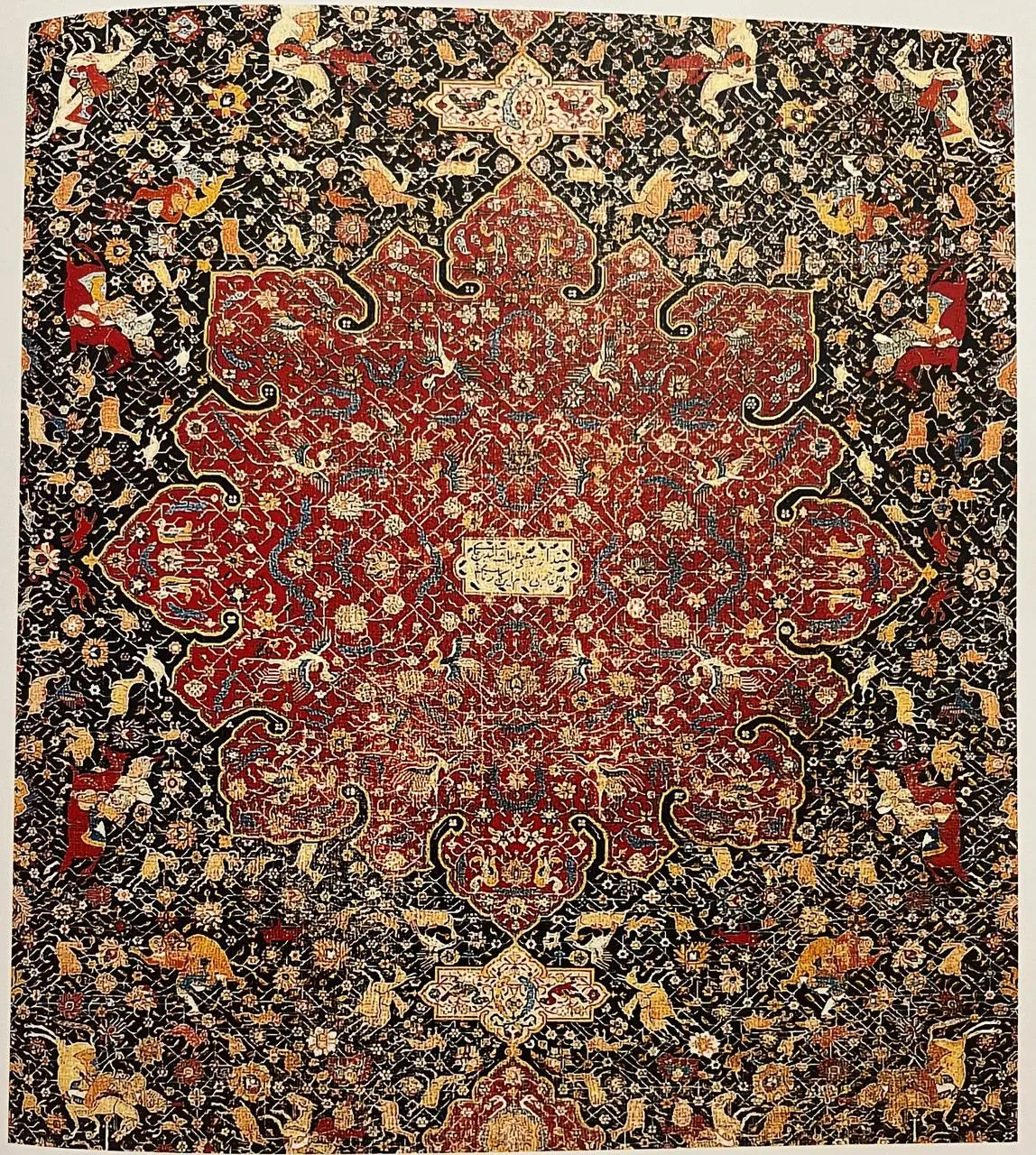All kinds of persian rug models
In Iran like Ottoman Turkey, flourishing of the art of carpet was related to the rise of a powerful kingdom entitled Safavid dynasty that ruled form 1502 to 1736. All kinds of persian rug models Iranian carpets in Safavid era Portuguese rugs Polonaise Vase Praying Medallion Hunting Garden

Garden rugs
Among adorning effective carpets related to Safavid era we could mention Garden Carpets that were generated from legendary Baharestan, the very carpet of Sassanid that was taken by victorious Arabs. In older samples, background was divided into rectanGülar gardens with trees, flower and bird; there was water with fish, duck and mythical animals between two gardens. These carpets were inspired from Iranian gardens or Paradise.

Paradise is a place with tall walls that prevent entering evil forces. There is a lot of water inside and all types of wild and domestic animals, plants, flowers and trees. Iranian gardens were inspired from paradise and considered safe and holly places. In a dry land like Iran, building a garden is a kind of art and it has been mentioned in miniatures, poems and music, too. In Iranian gardens, different kinds of plants were cultivated in reGülar parts and there was a network of canals.
There were tall walls to make a safe place and defend.

In gardens, there were geometrical divisions and garden with different trees and flowers. Canals full of fish and other marine animals separated each garden from others: in each crossroad, water was in a pool made by colorful ceramic or marble. The earth had a mild slope to have a continuous flow of water. Simpler structure was called “Charbagh” that were composed of four gardens, which were divided by two perpendicular ca-nals. In many cases gardens had more sophisticated structure.

Garden carpets have been knotted in different workshops but many remained samples are related to Kerman based on their structures. Among older samples that portrayed garden in a real situation, we can mention carpet of Maraja Dijaipour that was found in a hidden store in Amber palace. This carpet is in large scale and shows a garden with a tent in the center surrounded by pools, canals full of fish and ducks and there are trees that under their shadows deer and other animals are grazing. It’s written on a label that in 1632 was bought by Mirza Raja Jay Sing and many research confirmed that probably it’s woven in Iran and Shah Abbas period (1587-1629). It’s one of the most elegant and precious garden carpets that are keeping in Jaipur Museum.

Simplified designs were employed over the time. An interesting example of middle carpets in geometric designs are still not far from the real issue is held at the Museum of MAK in Vienna. It’s called Figdor that is taken from a collector named Albert Figdor who found the very carpet in Ehrenhausen near Graz. This carpet backs to eighteenth century and is related to Kerman.

Hunting rugs
Another group of carpets wove in Safavid era is carpets with images of hunting.
Animal hunting is illustrated in these carpets that was obvious in Iranian ancient art like what exists on embossed pictures of Assyrian and Achaemenid. Carpets with images of hunting were woven in different cities of ran in sixteenth century. A specific subcategory of these carpets in small sizes show animal battles and is often symmetrical and wove around central medallion and are called Sanguszko.

This name is derived from a valuable sample keeping in Thyssen Bornemisza collection, a very specific wove carpet with silk. A red spectrum to purple is seen in that and is related to Kashan.

One of famous hunting carpets of Safavid is keeping in Museum of Poldi Pezzoli in Milan. It was found after travel Pop IX Pio in Quirinale, Italy. The carpet was reconstructed in Vatican and used in royal village in Monza. In 1919 when Savoia family left the royal village of Monza, it was delivered to the Italian government. Therefore, the very carpet transferred to Museum of Brera and later in 1923 was taken to temporary stock of Poldi Pezzoli. There is an epigraph on this carpet with a poem in addition to signature and date.

It has been considered as the most precious work of Safavid period. It was coincident with 1522-1523 based on Arthur Poop and research of author in the book of “Kings’ hunting” and probably belonged to northwest of Iran. The center of background is adorned with a big red medallion that around it and on the background, fine decorations with the images of hunting and horse riders are seen.
The carpet is in 56.3X82.6 cm and the elegance of weaving on silky warps brings this idea to the mind that it might be woven for court. Elegance of the design poses the hypotheses that Qyas al-din Jami could have been a royal miniaturist.

Medallion rugs
Undoubtedly the precious carpets of Safavid were medallion carpets. Medallions of carpet were used in other textiles and calligraphies in Safavid era. The importance of medallion has been proved in Iran because it’s still common as a design. Medallions can have different adorning and allocate the space of one fourth of each side of the carpet to themselves.

One of the most precious and valuable medallion carpets is keeping in Museum of Victoria and Albert in London. This carpet is known “Ardebil Carpet” because it has been discovered in that city. The carpet has a circular big medallion that has been connected to sixteen drop-shaped hangers and two mosque lamp can be seen on a blue background adorned with flowers, large numbers of branches and loops.
In March 1893, Museum of South Kensington in London that nowadays is called Victoria and Albert bought this carpet 2200 ponds from Vincent Robinson that this company has bought the carpet from Ziegler, a European com-pany.

Ziegler was a commercial company that noted to carpet a lot and one of the most active branches of that was in Tabriz. In 1914, another carpet was found in USA that was similar to the carpet of Museum of Victoria and Albert and was bought by John Paul Gatty for Museum of Los Angeles. This carpet was terribly hurt and some parts had been destroyed and raised the hypotheses that this destruction had been done during an amateur reconstruction in nineteenth century. Although form the finding it was believed that it belonged to mosque of Sheikh Safi in Ardebil, there is no reliable information about it: the carpet has not been mentioned in the list of properties of mosque and its purchasing procedure by Ziegler is vague.

There are two hypotheses that it belong to the treasury of mosque: two travel accounts related to 1843 that a big and old carpet has been mentioned in. to globe trot-ters, Abbot and Holms, mentioned that there was a date on the carpet that based on Abbot it was 946. Holms quoted remains of a pale and valuable carpet that the date of weaving had been written on the end of carpet that was about three centuries before his visit. There is a date, signature and epigraph on the end of Ardebil carpet with a verse of poems of Hafiz:
There is no shelter but your Threshold for me, There is no reference for me but this place Performance of God’s servant, Maghsoud Kashani (946)

946 A. H. coincident with 1539-1540 A.C
Undoubtedly, carpets of Tabriz, Kashan or Mashhad wove by peerless artists in Safavid era have been matchless works. They have been precious and wove by a shrine or court. They were big and too elegant. Ardebil carpet of Museum of London is in 1152 cm length and 534 cm width. There are Woolen knots on silky warps and there are 3 wefts of that material after each row of knots. Density of knots is more than five hundred knots per each dm2.

Praying rugs
In safavid era praying carpets were so usual in Iran.
They had a sanctuary with Horseshoe-shaped arch and usually in a row, i.e. some in a single file were wove.
An Iranian miniature that is keeping in National Library of Paris illustrated the Prophet praying on such carpet.
Religious carpets had some specific features: Quran texts on all top half of the carpet had been repeated, i.e. the part that prayer puts his forehead on. The other texts are adorning two sides and there are frames to comply the sanctuary. Images of simplified mosque lamp or epigraphs were wove inside the carpet and mostly fine flowers or clouds were used for adorning.

Vase rugs
A wider group of Safavid carpets, which are famous today and are called “Vase Carpets” and are mostly related to Kerman. There are unique samples of this kind of carpet that have been remained fully, some parts have been destroyed or just some parts have been remained.

Some of them are big and long. Background is occupied reGülarly without any superiority in adorning and there is no medallion or corner.
It’s called vase carpet because there are floral designs in the background launched from one or some vases in most samples not all. And there are small vases in the bottom of the carpet. There are level of complexity in this kind of carpet and are out around one or some stems. Central stem can be in different directions and in some cases it makes a netted design with diamond-like networks. There is Shah Abbasi with petals on the top of stems and wound leaves and fine flowers that are either connected to the stem or are in cluster enrich the de-sign.

Border images are usualyy less than background, although fine floral designs are used to decorate bor-der, too: we can mention Strapwork among employed wound designs that is sometimes with epigraph. But there are a lot of samples with wound designs form Shah Abbasi and rose that is separated with different decorations or the sequence of the flowering stem is seen with a naturalistic style.
It seems that this design had been developed in the seventeenth century and the beginning of eighteenth century and a mesh design of the stems with floral decorative elements could be seen on it.

Technically vase carpets of Safavid had the following features: The structure of warp is common for most of the carpets of that era, with warps of cotton that have four threads spinning together and usually in natural Ivory color but sometimes dyed fibers in azure blue or red light can also be seen. Anyway one feature of vase carpets of Kerman was passing three wefts after each row of knots: the first and third wefts were woolen, thick and firm as warps were in two different levels but second woof was loose and narrow.

Polonaise rugs
During seventeenth century, most of Safavid carpets entered the European courts. In these carpets, which had been wove for exportation, fine, materials such, as silk, gold and silver were used and finally they were used in luxurious houses. Savoia palace had two of such carpets. Aforementioned carpets were called Polonaise because a polish blue-blooded named prince Czartoryski exhibited a lot of samples of these carpets in Paris exhibition in 1878.

Historical sources mentioned that King of Poland, Sigismondo Ill, sent an Armenian businessman named Sefer Muratowicz, to Kashan in Iran in 1602 to prepare Iranian carpets for royal palace.
Carpets of Sigismondo III is keeping in Museum of Residenz in Monaco situated in Baviera with textiles belonged to the dowry of Anna Katrina, dough-ter of the King who married Palatino Ettore, is in there, either. Other carpets are in the Museum of Diocesano in Studzianna in Poland that Sobieski III Giovanni bestowed them to the treasury of church after victory on Turkish.
Polonaise carpetsare from silk and are wove from a structure of cotton. Some parts are technically woven by wefts of gold and silver. These carpets enjoy a substantial level of elegance and sophisticated and fine design with different colors mostly light and close to each other and colors are rarely contrast each other. in most of them a knot is on a warp.

Important issue is that in some of them two-sided pile can be seen. It means that the pile of the carpet is form two sides of the carpet toward canter. This condition is due to employing specific instrument that two groups of weavers had been weaving in two sides.

Portuguese rugs
The effect of commercial ties between occident and orient is obvious in another sample of carpet which is famous as Portuguese because there are boats wove in the corners that are guided by bearded men who are dressed in European clothes: they may Portuguese who were working in Hormoz port in Persian Gülf. Undoubtedly when they came back home, they brought a lot of carpets in their ship. So it can be the reason of being a lot of Iranian carpets of Safavid in museums of Portugal, Museum of Gülbenkian Calouste, Museum of Ancient National Arts in Lisbun and Museum of Abade do Bacal.

There are a lot of hypotheses about the origin of these carpets that a wide area from Goa, colony of Portugal, to south or north of Iran can be con-sidered. Structures of the carpets are not of help.
Portuguese carpets have been wove on warps from cotton and mostly with a style that was common in India rather than Iran. In some cases double knots can be seen so it is based on carpet weaving of khorasan and Heart.
The period of peace and prosperity coincident with perfect art is closely related to the power of the Safavid dynasty. The century that followed the fall of the last king of the Safavid in 1732 and Zand and Qajar dynasties came to power, was filled with suffering prolonged wars.

For this reason and because of lack of resources, After Safavid dynasty luminosity and massive produc-tion, art of carpet weaving was almost faded in Iran in the end of seventeenth and eighteenth centuries and then again, as if a miracle has been occurred in nineteenth and twentieth centuries, it’s risen from the ashes like phoenix. Although on one hand, we believe that the activities of weaving for the court was stopped, on the other hand, it seems that carpet weaving in the city has continued to remain in power. Carpet glow in the eighteenth century lead us to the point that by assist of the presence of a small number of signed and dated samples which are documents showing the activity of the centers and at the same time their remarkable ability to innovations and after exports to the occident, an opportunity had been appeared to introduce this art to the world.

Image of a carpet belonged to Rudolf Martin (1864-
1925) famous German anthropologist
There is a noticeable elegance in the weaving of this carpet and silk and braid threads have been used for background. Carpet has epigraphs on the borders that are counter clockwise and initiated form right bottom.
A verse of following poem is wove in each one:
Since there is a sign of earth and sky
Ottomans are gods
On the pulpit of justice and fortune
They are content and prosperous forever
Adorning of coin and speech
Is the name of King Morad Khan In Iran like Turkish and Arabic lands
A person like you is a champion
May you live forever
Existence of the world is on you Your servant like Mirza Makhdum
Is superior than all human
It can be understood that this carpet was a gift from Safavid King Abbas to Ottoman King, Morad III, who ruled from 1574 to 1595 in Anatolia.

In that time, Mirza Khatum or Makhdum Sharifi was a judge in Mecca.
This carpet was considered a part of Salting wide carpet collection. It means a carpet that was related to Iran and Safavid era based on appearance but in the beginning of twentieth century this classification became wrong.
But after some research by technique and scientific tests like carbon 14, it was clear that this carpet has been wove in sixteenth and seventeenth centuries.
Its enrichment, beauty, epigraphs and asymmetrical wound flowers caused to put this carpet it with famous praying carpet of Mawlana’s tomb in Konya, which is said it’s the gift of Ottoman King after his returning from Iran, in one class.

